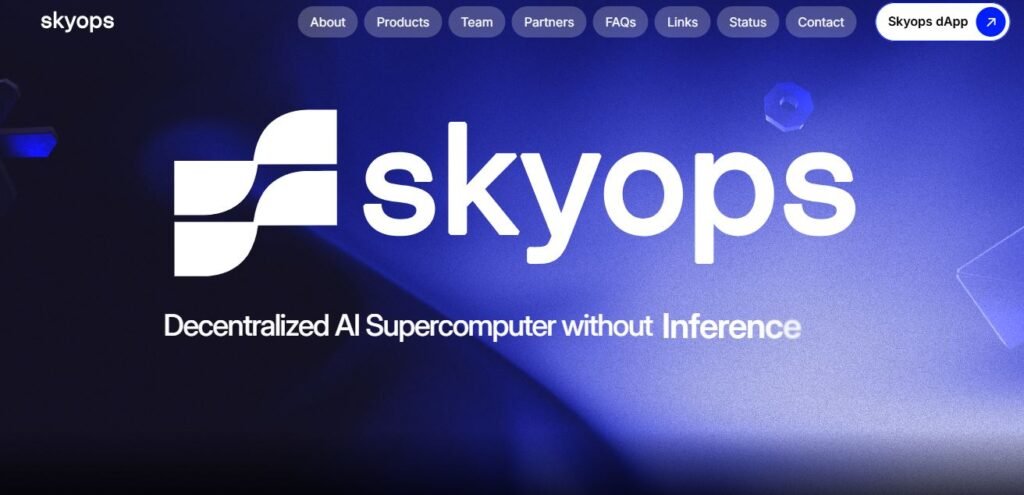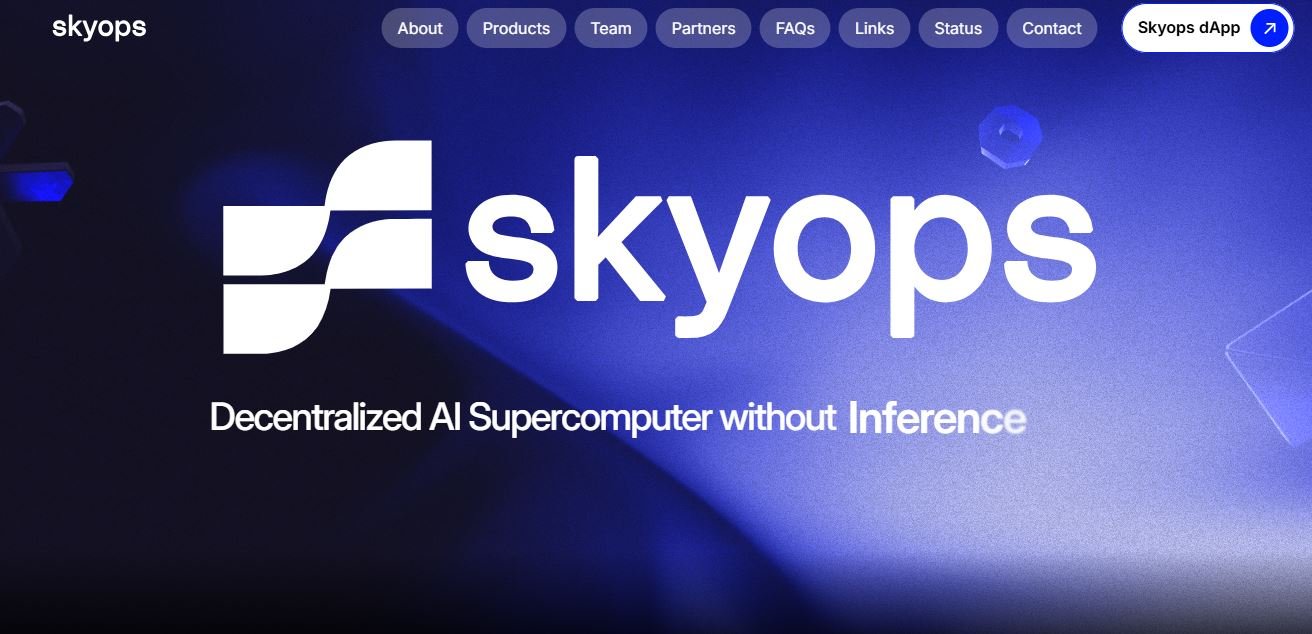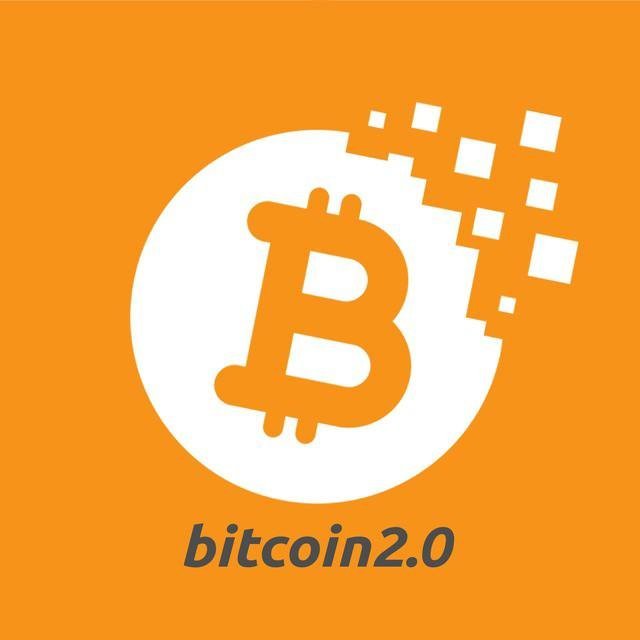What Is Skyops (SKYOPS)? A New Decentralized AI Compute Platform Explained
What Is Skyops?
A New Player in Decentralized AI Compute
Skyops is an emerging decentralized GPU computing platform designed to revolutionize the way artificial intelligence (AI) workloads are processed. Instead of relying on centralized cloud services like AWS or Google Cloud, Skyops taps into a global network of underutilized GPU resources. This approach allows developers, researchers, and businesses to access affordable, scalable, and efficient compute power without traditional infrastructure bottlenecks.

By leveraging blockchain technology and a decentralized scheduler, Skyops dynamically matches compute jobs with idle GPU nodes. It supports various types of GPU hardware, offering a flexible and fault-tolerant environment for intensive tasks such as AI model training, fine-tuning, and inference.
Table of Contents
Mission and Vision of Skyops
Skyops’ mission is to democratize access to AI compute power by creating a decentralized, community-driven network where anyone can contribute and benefit. The platform aims to eliminate the high costs, central control, and gatekeeping associated with legacy cloud providers.
The long-term vision of Skyops is to become the foundational layer for decentralized AI infrastructure — a permissionless ecosystem where small teams, independent developers, and underfunded researchers can build and deploy AI models at scale. By removing financial and technical barriers, Skyops empowers innovation from the grassroots and fosters a more inclusive AI future.
How Skyops Works
Decentralized GPU Resource Sharing
At the core of Skyops is a decentralized marketplace that connects compute demand with idle GPU supply. Anyone with spare GPU power—whether individuals, data centers, or organizations—can contribute their resources to the network. In return, they are rewarded with SKYOPS tokens based on their uptime, reliability, and performance.
This model transforms otherwise unused GPU cycles into a valuable resource for running compute-intensive AI tasks. The more participants contribute, the more scalable and robust the network becomes.
Matching Compute Jobs with Idle GPU Nodes
Skyops uses a decentralized scheduling algorithm to match incoming AI workloads with suitable GPU providers. The scheduler considers several factors, including hardware compatibility, geographic distribution, load balancing, and historical node reliability.
Unlike centralized services that operate in fixed regions with limited flexibility, Skyops is hardware-agnostic and globally distributed, enabling real-time optimization of compute resources.
Fault Tolerance and Redundancy in Compute Jobs
To ensure reliable execution, Skyops incorporates probabilistic redundancy—a method that assigns the same task to multiple nodes and validates results by comparing outputs. This system reduces the risk of failure or manipulation while maintaining performance.
In addition, Skyops uses real-time performance analytics to monitor the health of the network and quickly reassign jobs if a node becomes unresponsive. This fault-tolerant design guarantees uptime and job integrity, even in a decentralized environment.
Key Features of the Skyops Platform
GPU Mining via Chrome Extension
Skyops makes it incredibly easy for individuals to contribute GPU power through its Chrome Extension. Once installed, users can passively mine GPU points by allowing Skyops to utilize their idle graphics processing resources. This provides a low-barrier entry point for anyone with a capable GPU to participate in the decentralized AI economy and earn SKYOPS tokens without complex setups.
Extension Link: Skyops Chrome Extension
CLI Tools for Developers and Researchers
For AI professionals who require direct control over job execution, Skyops offers a robust Command-Line Interface (CLI). This tool allows for:
- Submitting training and inference jobs
- Monitoring job status and GPU usage
- Managing priorities and resource allocation
- Automating workflows with scripts
The CLI is designed to support a variety of AI frameworks and environments, giving developers full flexibility while maintaining the advantages of decentralization.
Web-Based dApp for Job Submission and Monitoring
Skyops also provides a web-based decentralized application (dApp) where users can easily manage compute tasks through a graphical interface. Features include:
- Uploading datasets and models
- Tracking task progress
- Viewing GPU provider stats
- Managing wallet-based payments in SKYOPS tokens
This intuitive dApp bridges the gap between technical and non-technical users, making decentralized compute more accessible.
Try it here: Skyops dApp
Real-Time Performance Analytics and Task Validation
Skyops employs a transparent monitoring layer that tracks node performance, task accuracy, and job completion times in real time. This data is used to:
- Rate node reliability
- Validate task outputs through redundant execution
- Optimize the scheduler’s decision-making process
These performance analytics ensure the integrity of the system while allowing for continuous improvement and trustless coordination among participants.
SKYOPS Token Explained
Use Cases – Payments, Rewards, Staking, Governance
The SKYOPS token is the backbone of the Skyops ecosystem. It serves multiple roles that are critical to the platform’s functionality:
- Payments: Users pay for GPU compute jobs in SKYOPS tokens, creating continuous demand for the asset.
- Rewards: GPU node operators earn SKYOPS for contributing compute power, with earnings tied to performance and uptime.
- Staking: Users can stake SKYOPS tokens to prioritize their compute jobs, giving them faster access to high-performance nodes.
- Governance: Token holders can participate in the decision-making process by voting on proposals, such as protocol upgrades and reward distributions
Tokenomics: Supply, Market Cap, FDV
Here’s a snapshot of the SKYOPS token’s core metrics (as of May 27, 2025):
- Total Supply: 100,000,000 SKYOPS
- Market Cap: $226.59K
- 24h Volume: $57.04K
- Fully Diluted Valuation (FDV): $386.06K
- Volume/Market Cap Ratio (24h): 25.17%
These early-stage figures suggest growing market interest and active trading, while still being accessible for early adopters.
Where to Buy SKYOPS and How It’s Secured
- Availability: SKYOPS is listed on decentralized exchanges (DEXs), and liquidity is locked via UNCX, ensuring long-term security and preventing rug pulls.
- Security: Contract ownership has been renounced, making the smart contract immutable and reducing central control.
- Transparency: All token movements and smart contract functions are verifiable on-chain, supporting Skyops’ commitment to full transparency.
Governance and Decentralization
Renounced Ownership and Locked Liquidity
Skyops takes decentralization seriously by ensuring that its smart contract ownership is fully renounced. This means no single party can alter the contract’s behavior, preventing centralized control or manipulation.
In addition, liquidity is permanently locked via UNCX, which prevents the development team or any malicious actor from withdrawing funds from the liquidity pool. This provides a higher level of investor confidence and long-term platform stability.
Community-Driven Governance Proposals
Skyops embraces a decentralized autonomous organization (DAO) model, allowing SKYOPS token holders to participate in governance. This includes the ability to propose and vote on:
- Network upgrades
- Reward distribution models
- Staking parameters
- Node reputation algorithms
- Feature integrations and roadmap priorities
Governance participation is weighted by the amount of SKYOPS tokens held or staked, incentivizing active involvement in shaping the future of the platform.
Transparency in Token Distribution
Unlike many blockchain projects that obscure token allocations, Skyops follows a fully transparent token distribution model. Token breakdowns, unlock schedules, and vesting periods are publicly verifiable, with no hidden developer wallets or unfair pre-mines.
This open approach builds trust among contributors, GPU providers, and investors, reinforcing Skyops’ mission to build an equitable and open AI compute ecosystem.
Benefits of Using Skyops Over Traditional Cloud Providers
Cost Efficiency and Accessibility
One of the most compelling advantages of Skyops is its significantly lower cost compared to centralized cloud services like AWS, Azure, or Google Cloud. By tapping into a global pool of underutilized GPUs, Skyops avoids the massive overhead associated with centralized data centers.
This makes it possible for:
- Independent developers
- Research labs
- AI startups
- Open-source projects
to access affordable compute power previously out of reach due to pricing barriers.
No Vendor Lock-In
Unlike traditional cloud providers, Skyops offers complete freedom and portability. Users aren’t tied to a single provider’s APIs, hardware, or pricing structures. Jobs can be deployed across multiple GPU nodes with varying configurations, promoting diversity and reducing dependency.
Skyops uses open protocols and provides support for mainstream AI frameworks, allowing developers to retain control over their workflow, infrastructure, and data.
Empowering Independent Developers and Small Teams
Skyops is designed to level the playing field. While tech giants have access to enormous compute infrastructure, smaller teams often struggle to compete due to limited budgets and resources.
With Skyops:
- A small AI team can train large models affordably
- Hobbyists can monetize idle GPUs from home
- Researchers in developing regions can run compute jobs without relying on centralized, expensive infrastructure
The Team and Launch Details
Backgrounds in Blockchain, AI, and Distributed Systems
Skyops was launched on May 23, 2025 by a globally distributed team with deep expertise in:
- Blockchain infrastructure – ensuring secure, decentralized protocol design
- AI model training and deployment – understanding the real-world demands of machine learning workflows
- Distributed systems engineering – building resilient, scalable, fault-tolerant compute networks
This multidisciplinary approach has enabled the team to create a platform that bridges the gap between decentralized finance (DeFi) principles and practical AI compute needs.
Launch Date and Roadmap Highlights
Skyops officially went live on May 23, 2025, and has already achieved key early milestones, including:
- 🚀 Deployment of the mainnet platform
- 🧩 Launch of the web-based dApp
- 🔌 Release of the Chrome extension for GPU mining
- 🔒 Liquidity locked on UNCX and ownership renounced
- 📈 Initial listings and token metrics visible on market data platforms
Upcoming roadmap features may include:
- Multi-chain support for cross-chain compute jobs
- Enhanced staking and rewards logic
- Developer grants and GPU provider incentive programs
- Mobile dashboard app for monitoring compute jobs on the go
The Skyops team continues to engage the community for feedback and improvements, reinforcing its commitment to transparency and open governance.
Final Thoughts – Why Skyops Matters in 2025 and Beyond
Closing Summary
Skyops represents a significant leap forward in how AI compute power is accessed, allocated, and monetized. By combining decentralized blockchain infrastructure with a real-world use case—distributed GPU computing—it offers a viable, scalable alternative to traditional cloud giants like AWS and Google Cloud.
Key takeaways:
- ✅ Decentralized GPU marketplace that rewards contributors
- ✅ Accessible AI compute for developers, researchers, and startups
- ✅ Robust infrastructure with fault tolerance, job validation, and real-time monitoring
- ✅ Multi-utility token (SKYOPS) for payments, staking, and governance
- ✅ Community-driven project with locked liquidity and transparent tokenomics
How to Get Involved
Whether you’re an investor, developer, or someone with idle GPU power, Skyops offers multiple ways to participate:
- 💻 Run AI workloads or fine-tune models on the Skyops dApp
- 📦 Contribute compute resources with the Chrome Extension
- 💰 Buy or stake SKYOPS tokens to support and shape the platform
- 🗳️ Join governance votes and influence protocol evolution
- 🌐 Follow updates on SkyopsLabs.ai
Skyops is more than just a token—it’s the foundation of a decentralized AI economy. As demand for machine learning continues to surge globally, platforms like Skyops could play a vital role in democratizing innovation and building a more inclusive tech future.
Read Also: Retardcoin ($RETARD): No Roadmap, No Utility — Just Moon Vibes






